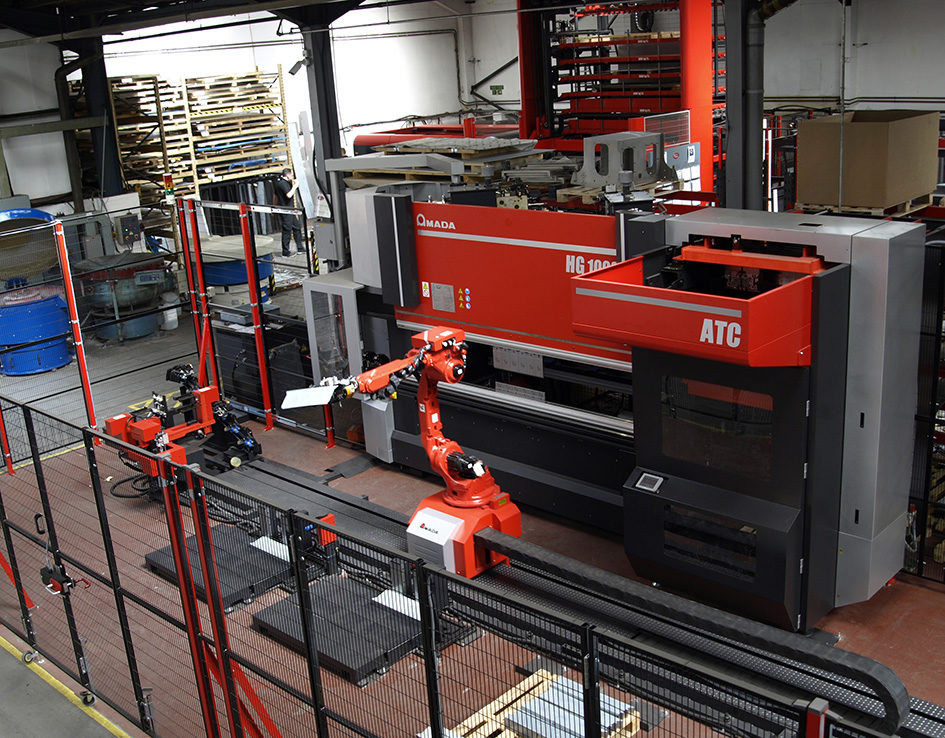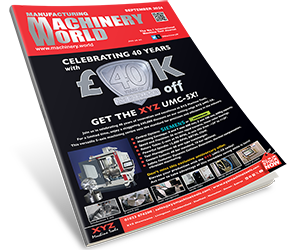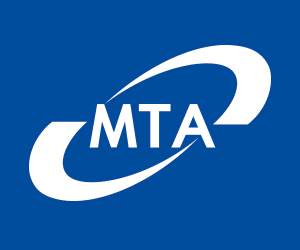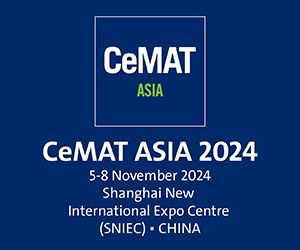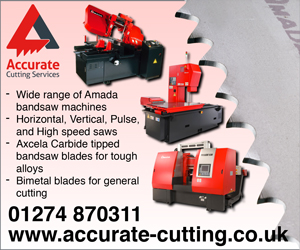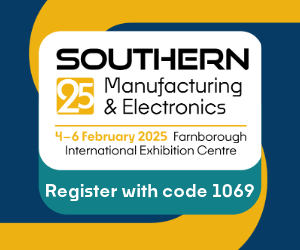Punch press and press brake technology is continuing to evolve as sheet metal and fabrication shops seek further gains in the quest for competitive advantage. Take Harlow-based Young & Woods for example, a provider of sheet metal solutions to a variety of industries. This small but progressive company has recently taken delivery of a Punch Genius turret punch from Prima Power.
“We consider that investing in the best available machinery pays major dividends in terms of equipment reliability and both the quality and volume of our output,” explains director Alan Lee.
Purchased to increase the company’s punch press capacity, Young & Woods’ Punch Genius is a new-generation turret punch press that uses NC servo-electric axes. Reflecting the company’s strategy of acquiring the latest machinery, the punch press is the first model of the recently launched Punch Genius range to be installed in the UK.
“When we compared the performance of the new Punch Genius with the turret punch presses available from other suppliers, we found that the latest Prima Power machine had a very impressive speed of operation, delivered outstanding energy efficiency and had low maintenance requirements,” says Alan Lee.
Another UK first can be found at the Northampton facility of subcontractor, Recol Ltd. The company has become the country’s first user of Amada’s new HG ARs automated press brake system. The adoption of robot-tended bending operations is not only providing a reduction in labour costs for Recol, but thanks to the system’s integral automatic tool changer (ATC), has cut set-up times from 45 minutes to just 90 seconds in some instances.
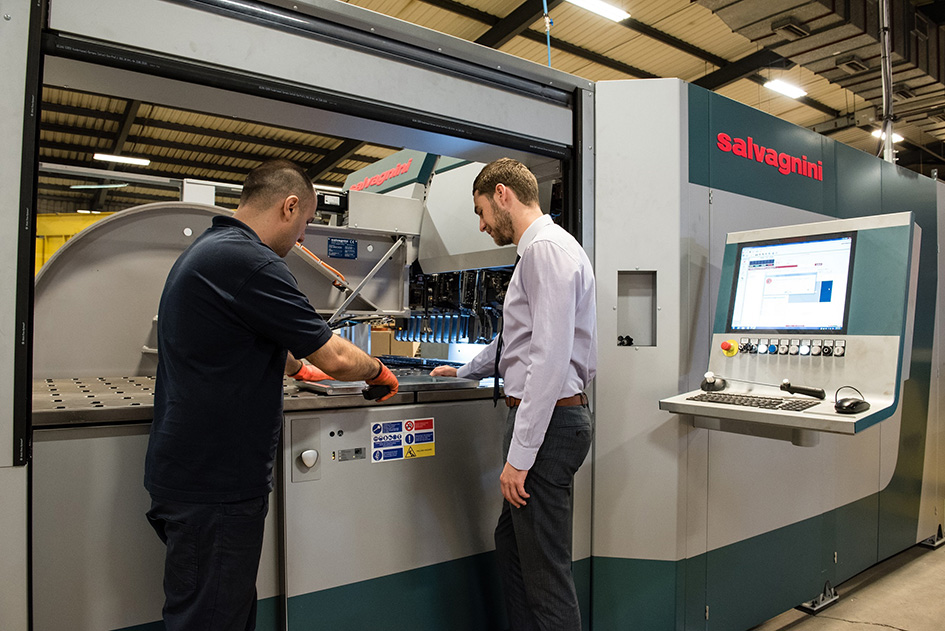
“Labour is the biggest cost to any business like ours, and we knew that introducing automation into our bending operations would deliver significant gains,” states director Ben Guntrip.
The HG ARs is a fully integrated robotic press brake system with a six-axis robot, automatic gripper changer and ATC with patented Amada tooling. Each stage of the bending process, including tool loading, gripper exchange and robotic bending, is performed at high speed to maintain machine productivity.
“With the HG ARs, the operator simply pushes the button and walks away to start doing other things, such as programming new jobs,” says Ben Guntrip. “Furthermore, with the ATC we can change jobs really quickly. For instance, setting up one of our manual press brakes for a complex bending job can take 45 minutes. However, this is reduced to around 90 seconds using the HG ARs. Differences of such magnitude are game-changers.”
In terms of new press brake developments, among the latest innovations is Synchro-Form, LVD’s next-generation adaptive bending system. Synchro-Form has been designed to automatically maintain angular consistency and the required geometric profile when handling, positioning and bending large parts with multiple bends.
The system is said to overcome the problems of accumulative error and trial-and-error bending when forming large profiles. It uses a laser scanner and synchro modules to manipulate, position and measure each bend, relaying the digital information to the Touch-B control, which makes adjustments to part and ram position to achieve the correct profile. Variations are not accumulated but, instead, compensated with each bend step.
So, what of panel benders and CNC folding machines? Well, investment levels are strong here too. For instance, Lasershape, a Nottingham-based supplier of subcontract laser cut components, has just installed the highest specification Salvagnini panel bender in the UK, along with a 4m Bystronic CNC press brake.
“We have been considering a panel bender for our thinner section sheet for some time,” says Adam England, Lasershape’s planning and estimation manager. “We were attracted to the technology primarily because there is no tool change or set-up time, unlike a press brake where 15-30 minutes is typical.”
The Salvagnini P2 Lean includes a CLA negative auxiliary bending tool, which is particularly useful for downward window bends or welding tabs that require sectionalised tooling. The machine also offers DPM, a special unit with suction cups that permits the manipulation foot to move aside and allow narrower profiles. Also featured is CLA SIM for automatic auxiliary bending blade composition, and P Tool, which allows various tools to be inserted under the blanking tool to perform embossing very close to the bend line without any crushing effect, for example.
“Having this machine means we can target different types of industries, particularly those requiring thinner gauge, box-type products, such as refrigeration, shop-fitting, electrical enclosures and HVAC,” says Adam England. “It can fold far quicker than a standard operator, typically one fold per second.”
Despite the advances offered by the new panel bender at Lasershape, demand for conventional press brake work continues apace. As a result, the company has just introduced its first 4m press brake, a Bystronic Xact Smart 225/4100, adding to the range of 3m models already on site. Among the industries driving demand for long press brake parts is the commercial vehicle sector, specifically truck bodies.
Over at the Telford facility of Proteus Switchgear, the company says that throughput of bent sheet metal components is just as high using a manually operated, CNC folding machine as it was when the company was using a fully automated panel bender. Purchased through sole UK agent, Press & Shear, a RAS FLEXIbend 73.30 all-electric model has taken over from an automated, hydraulically-actuated machine from another supplier in 2016.
The new CNC folding centre is providing not only equivalent productivity but also greater flexibility for bending small to medium batches of switchgear cabinet components. Typical runs are from 10- to 20-off, and occasionally up to 50-off.
The machine also delivers improved bending precision, helped by its rigid construction and a patented, intelligent crowning system featuring sensors that measure and compensate automatically for folding beam deflection. Positional accuracy is within ±0.1mm.
Andy Roberts, the company’s CNC programmer, says: “Our previous, automated folding machine was nearing the end of its useful life and to replace it would have cost €500,000. In contrast, the FLEXIbend was one-third of the price. We were concerned that, not being automated, it would not be able to keep up with production so we retained our automated machine for a while to work alongside it. However, we only used it two or three times in the first four months after delivery of the FLEXIbend, so have now taken it out.”


